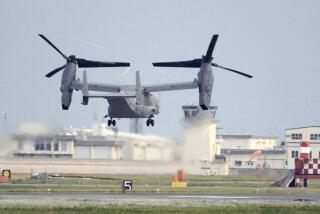U.S. Team Gets Possible MIA Remains : Human Teeth, Bones Found at Laos Site of U.S. Plane Crash
- Share via
NONG SONG HONG, Laos — U.S. experts found bone fragments, human teeth and personal effects at the crash site of a U.S. Air Force warplane shot down in the Laotian jungle in 1972, American military officials said today.
The excavation of the crash site of an AC-130 gunship marked the first time a U.S. military team was allowed to search in Indochina’s three communist countries for American servicemen missing in action during the Vietnam War.
Thirteen Americans were listed as MIA in the crash on Dec. 21, 1972, but U.S. officials refused to speculate whether human remains found in the jungle search could be traced to the missing servicemen.
“We have recovered remains at the crash site,” said Lt. Col. Joe Harvey, leader of the joint U.S.-Lao search effort and commander of the U.S. Army’s Joint Casualty Research Center in Hawaii.
Analysis by Experts
“We are not really going to know what we have until they are analyzed by the experts in Hawaii,” he said.
Harvey said “many personal effects” were found, such as helmets. Other searchers said the remains included human teeth and bone fragments.
The discovery of teeth would make identification easier because dental work can be compared with the missing men’s records.
The AC-130 carried 16 crewmen when it was shot down while attempting to return to its base in Thailand after a mission. Two crewmen were rescued and the body of another was recovered a few days later.
The crash site is in dense jungle 26 miles northeast of the provincial city of Pakse. No large pieces of the four-engine AC-130 were visible but metal fragments were strewn about the site.
The 12 Americans first searched the area on their hands and knees, using hunting knives to probe for remains. Harvey said “a considerable amount of unexploded ordnance” was strewn around the crash site, increasing the danger to searchers.
“Every shovelful of dirt that comes out of the hole has to be sifted through a sieve,” said Maj. Johnie Webb, commander of the Army’s Central Identification Laboratory in Hawaii.
The examination process is expected to take about a month.
More to Read
Sign up for Essential California
The most important California stories and recommendations in your inbox every morning.
You may occasionally receive promotional content from the Los Angeles Times.













